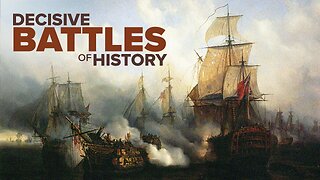Premium Only Content

The Italian Renaissance | Milan under the Visconti (Lecture 20)
Lecture 20: Milan was the model of the despotic monarchy. Ruling over the vast and fertile Lombard plain, the city had been briefly the capital of the late Roman Empire and, as the see of St. Ambrose, an important episcopal center during the Middle Ages. The struggles between the Ghibellines and Guelfs had, therefore, been particularly bitter. The Visconti family, which had ties to both factions, emerged victorious from the chaos, being formally recognized by the city in 1349 as hereditary rulers. By engaging in almost constant warfare and brutal repression, the Visconti built Milan into the most powerful state in northern Italy. The wealth of the rulers and the city, combined with the Visconti desire for lasting fame, stimulated the patronage of art and literature.
Giovanni Visconti (d. 1354), who ruled simultaneously as signore and archbishop of Milan, was Petrarch’s patron, and Giangaleazzo Visconti (d. 1402), who built a huge territorial state through brilliant diplomacy and warfare, began the celebrated cathedral and the monastery of Pavia. His successors were cruel, incompetent, and strange, culminating in the last of his line, Filippo Maria (d. 1447). Filippo married his natural daughter to the mercenary general Francesco Sforza (d. 1466), who seized the city and assumed the role of duke.
Secondary Sources:
E. R. Chamberlin, The Count of Virtue: Giangaleazzo Visconti.
Supplementary Reading:
Ernest Hatch Wilkins, Petrarch’s Eight Years in Milan.
Sergio Bertelli, Italian Renaissance Courts
Lecture 21: https://rumble.com/v4y43a9-the-italian-renaissance-milan-under-the-sforza-lecture-21.html
-
 30:05
30:05
The Great Courses
2 months agoDecisive Battles of World History | 1942 Stalingrad - Hitler's Ambitions Crushed (Lecture 35)
193 -
 2:33:04
2:33:04
Badlands Media
13 hours agoBaseless Conspiracies Ep. 147: Pole Shifts, Plasma Skies, and the Truth About Cataclysms
166K17 -
 4:33:42
4:33:42
Drew Hernandez
9 hours agoISRAEL BOMBS GAZA HOSPITAL ON LIVE TV KILLING AT LEAST 20 INCLUDING JOURNALISTS & CIVILIANS
20.8K67 -
 2:55:23
2:55:23
TimcastIRL
8 hours agoTrump Orders Specialized National Guard Units To Combat Crime In Cities, Dems Furious | Timcast IRL
205K146 -
 6:22:03
6:22:03
SpartakusLIVE
10 hours ago#1 Rocket CHAMPION of Verdansk wields UNSTOPPABLE new META
81.3K5 -
 2:55:11
2:55:11
Barry Cunningham
10 hours agoPRESIDENT TRUMP MADE TODAY A VERY BAD DAY TO BE A DEMOCRAT!
100K66 -
 1:15:29
1:15:29
Flyover Conservatives
1 day agoFrom Cool to Cringe: How Democrats Lost America’s Ear | FOC Show
48.1K14 -
 8:19
8:19
MattMorseTV
13 hours ago $8.93 earnedTrump is ACTUALLY DOING IT.
48.5K43 -
 11:30:43
11:30:43
ZWOGs
16 hours ago🔴LIVE IN 1440p! - Tarkov w/ Casey & crgoodw1n, Kingdom Come Deliverance, & More - Come Hang Out!
40.6K5 -
 2:30:56
2:30:56
We Like Shooting
20 hours ago $8.72 earnedWe Like Shooting 625 (Gun Podcast)
40.3K1